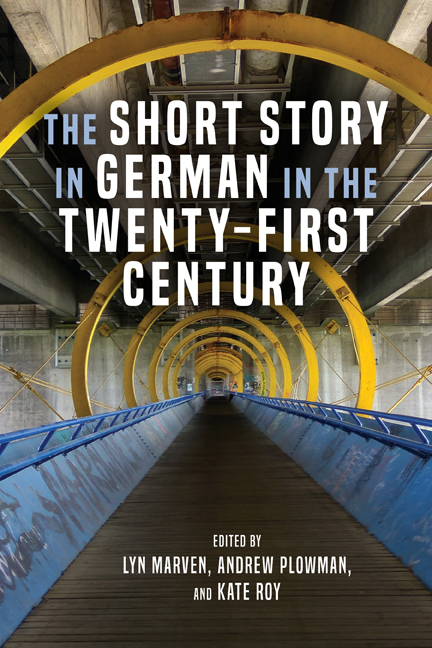Book contents
- Frontmatter
- Contents
- Acknowledgments
- Note on Translations
- Introduction to the Contemporary Short Story in German
- 1 Berlin Shorts: The German Capital in the Short Story of the Twenty-First Century
- 2 The German Crime Story in the Twenty-First Century
- 3 Performance, Performativity, and the Contemporary German Kurzgeschichte
- 4 Cramped Spaces, Creative Bottlenecks: Sudabeh Mohafez’s Das Zehn-Zeilen-Buch and the Short-Short
- 5 Bodo Kirchhoff’s Widerfahrnis: A Novelle for Our Time?
- 6 The Liminal Space of the Short Story: Clemens Meyer’s Die Nacht, die Lichter and Die stillen Trabanten
- 7 Framing the Presence: Judith Hermann’s Lettipark
- 8 Of Unhomed Subjects and Unsettled Voices: Alois Hotschnig’s Die Kinder Beruhigte Das Nicht
- 9 Authorial Development and Fluid Spaces in the “Complete Stories”: Peter Stamm’s Der Lauf Der Dinge
- 10 On Disappearing: Reading Ulrike Almut Sandig with Sylvia Bovenschen
- 11 Metamorphic Becomings: Yoko Tawada’s Opium Für Ovid: Ein Kopfkissenbuch Von 22 Frauen
- 12 Melinda Nadj Abonji and Jurczok 1001: Performance, Politics, and Poetry
- 13 Rhizomatic Wanderings: The Writings of Gabriele Petricek
- 14 Trends and Issues in the Contemporary German-Language Short Story
- Appendix: Contemporary German-Language Short Stories in Translation
- Bibliography of Primary Texts
- Notes on the Contributors
- Index
6 - The Liminal Space of the Short Story: Clemens Meyer’s Die Nacht, die Lichter and Die stillen Trabanten
Published online by Cambridge University Press: 09 February 2021
- Frontmatter
- Contents
- Acknowledgments
- Note on Translations
- Introduction to the Contemporary Short Story in German
- 1 Berlin Shorts: The German Capital in the Short Story of the Twenty-First Century
- 2 The German Crime Story in the Twenty-First Century
- 3 Performance, Performativity, and the Contemporary German Kurzgeschichte
- 4 Cramped Spaces, Creative Bottlenecks: Sudabeh Mohafez’s Das Zehn-Zeilen-Buch and the Short-Short
- 5 Bodo Kirchhoff’s Widerfahrnis: A Novelle for Our Time?
- 6 The Liminal Space of the Short Story: Clemens Meyer’s Die Nacht, die Lichter and Die stillen Trabanten
- 7 Framing the Presence: Judith Hermann’s Lettipark
- 8 Of Unhomed Subjects and Unsettled Voices: Alois Hotschnig’s Die Kinder Beruhigte Das Nicht
- 9 Authorial Development and Fluid Spaces in the “Complete Stories”: Peter Stamm’s Der Lauf Der Dinge
- 10 On Disappearing: Reading Ulrike Almut Sandig with Sylvia Bovenschen
- 11 Metamorphic Becomings: Yoko Tawada’s Opium Für Ovid: Ein Kopfkissenbuch Von 22 Frauen
- 12 Melinda Nadj Abonji and Jurczok 1001: Performance, Politics, and Poetry
- 13 Rhizomatic Wanderings: The Writings of Gabriele Petricek
- 14 Trends and Issues in the Contemporary German-Language Short Story
- Appendix: Contemporary German-Language Short Stories in Translation
- Bibliography of Primary Texts
- Notes on the Contributors
- Index
Summary
CLEMENS MEYER came to prominence in 2006 with the novel Als wir träumten (As We Were Dreaming). Since then, his star has continued to rise: in 2008 he published Die Nacht, die Lichter. Stories (The Night, the Lights; in English as All the Lights, 2011), followed in 2010 by Gewalten (“Violences” or “Powers”), a literary “Tagebuch” (diary). A second novel entitled Im Stein appeared in 2013 (In Stone; in English as Bricks and Mortar, 2013). Meyer's most recent work is a second collection of short stories: Die stillen Trabanten (The Silent Satellites, 2017). From the outset, his work has been consistently well received in German broadsheets and the international press alike and he has been recognized in a steady stream of national and international awards, including the Maria Cassens Prize (2006) and the Leipzig Book Fair prize (2008). More recently, Bricks and Mortar earned Meyer a place on the Man Booker International Prize long list and full-length film adaptations of Als wir träumten and the short story “In den Gangen” (In the Aisles) have brought his work to an even wider audience.
Meyer was born in 1977 in Halle in the former GDR, moving as a child to Leipzig, the city where he still lives and works. Although “any attempt to bracket [Meyer’s] writing as emblematic of post-unification Germany is futile,” and the author himself rejects the narrow interpretation of his figures as “Wendeverlierer” (unification losers), given that the author's adolescence coincided with seismic social and historical change it is not surprising that his work is profoundly shaped by the rapid and disorientating disappearance of the East German state and its replacement by the new Berlin Republic. Meyer's achievement is, however, to draw on this experience to portray a broad picture of human suffering and survival.
Many of his figures endure unemployment, poverty, addiction, violence, imprisonment, and loneliness. They live in cramped flats and often exist in ambiguous spaces that hover between here and there. Frequently, his protagonists are men battling to survive in an environment where traditional working-class male identity, based in the culture of heavy industry, is challenged by the flexible, mobile hegemonic masculine identity of global capitalism.
- Type
- Chapter
- Information
- The Short Story in German in the Twenty-First Century , pp. 118 - 136Publisher: Boydell & BrewerPrint publication year: 2020
- 1
- Cited by

